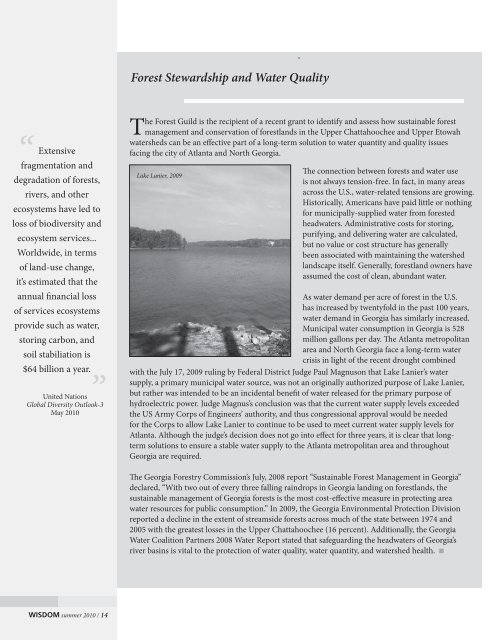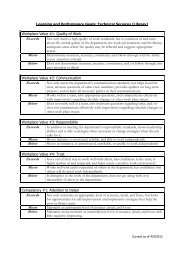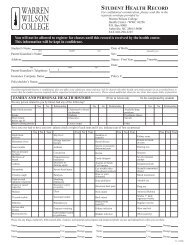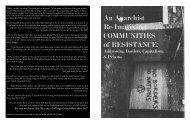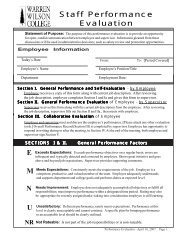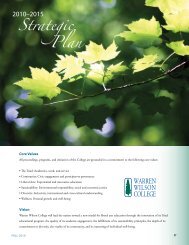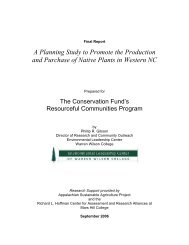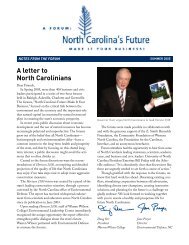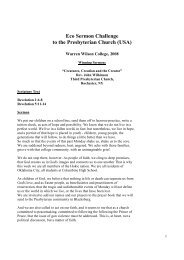Ecosystem Services - Forest Guild
Ecosystem Services - Forest Guild
Ecosystem Services - Forest Guild
- No tags were found...
You also want an ePaper? Increase the reach of your titles
YUMPU automatically turns print PDFs into web optimized ePapers that Google loves.
<strong>Forest</strong> Stewardship and Water Quality,“Extensivefragmentation anddegradation of forests,rivers, and otherecosystems have led toloss of biodiversity andecosystem services...Worldwide, in termsof land-use change,it’s estimated that theannual financial lossof services ecosystemsprovide such as water,storing carbon, andsoil stabiliation is$64 billion a year.”United NationsGlobal Diversity Outlook-3May 2010The <strong>Forest</strong> <strong>Guild</strong> is the recipient of a recent grant to identify and assess how sustainable forestmanagement and conservation of forestlands in the Upper Chattahoochee and Upper Etowahwatersheds can be an effective part of a long-term solution to water quantity and quality issuesfacing the city of Atlanta and North Georgia.Lake Lanier, 2009The connection between forests and water useis not always tension-free. In fact, in many areasacross the U.S., water-related tensions are growing.Historically, Americans have paid little or nothingfor municipally-supplied water from forestedheadwaters. Administrative costs for storing,purifying, and delivering water are calculated,but no value or cost structure has generallybeen associated with maintaining the watershedlandscape itself. Generally, forestland owners haveassumed the cost of clean, abundant water.As water demand per acre of forest in the U.S.has increased by twentyfold in the past 100 years,water demand in Georgia has similarly increased.Municipal water consumption in Georgia is 528million gallons per day. The Atlanta metropolitanarea and North Georgia face a long-term watercrisis in light of the recent drought combinedwith the July 17, 2009 ruling by Federal District Judge Paul Magnuson that Lake Lanier’s watersupply, a primary municipal water source, was not an originally authorized purpose of Lake Lanier,but rather was intended to be an incidental benefit of water released for the primary purpose ofhydroelectric power. Judge Magnus’s conclusion was that the current water supply levels exceededthe US Army Corps of Engineers’ authority, and thus congressional approval would be neededfor the Corps to allow Lake Lanier to continue to be used to meet current water supply levels forAtlanta. Although the judge’s decision does not go into effect for three years, it is clear that longtermsolutions to ensure a stable water supply to the Atlanta metropolitan area and throughoutGeorgia are required.The Georgia <strong>Forest</strong>ry Commission’s July, 2008 report “Sustainable <strong>Forest</strong> Management in Georgia”declared, “With two out of every three falling raindrops in Georgia landing on forestlands, thesustainable management of Georgia forests is the most cost-effective measure in protecting areawater resources for public consumption.” In 2009, the Georgia Environmental Protection Divisionreported a decline in the extent of streamside forests across much of the state between 1974 and2005 with the greatest losses in the Upper Chattahoochee (16 percent). Additionally, the GeorgiaWater Coalition Partners 2008 Water Report stated that safeguarding the headwaters of Georgia’sriver basins is vital to the protection of water quality, water quantity, and watershed health.WISDOM summer 2010 / 14


